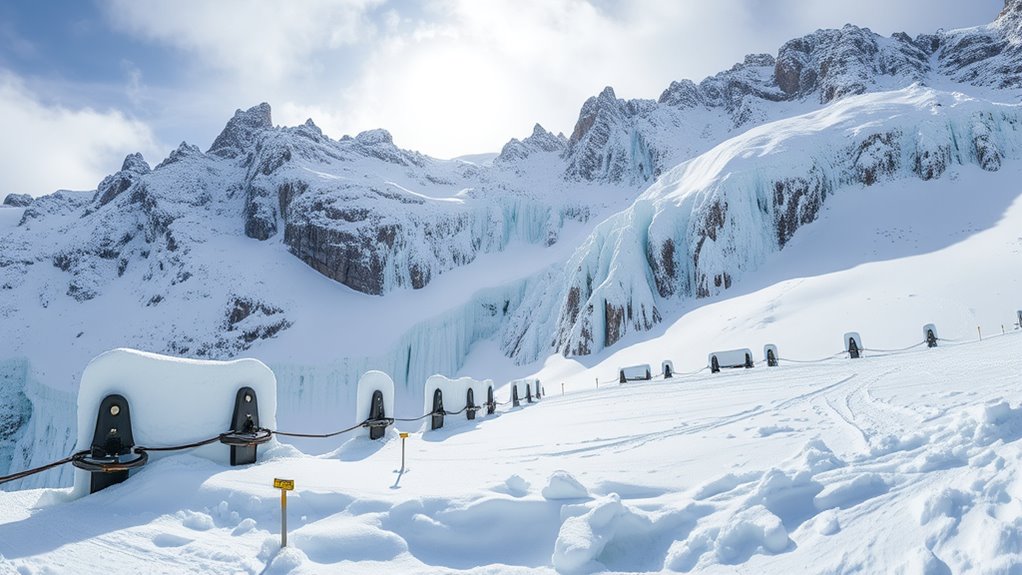To prevent ice shear at snow edges, focus on understanding how stress from temperature changes, uneven load distribution, and external forces weaken ice. Regularly monitor cracks, snow buildup, and movement, and reinforce edges with compacted snow, barriers, or supportive materials. Managing snow loads and insulating vulnerable areas also helps. By staying aware of early signs and implementing proper techniques, you can reduce risks—they’ll learn more effective strategies as they explore further.
Key Takeaways
- Recognize early signs of shear failure, such as cracks or shifting snow, through regular inspections and visual monitoring.
- Manage load distribution by evenly spreading snow and removing excess to reduce stress on ice edges.
- Reinforce edges with compacted snow, gravel, or structural supports like barriers and tension cables.
- Control temperature fluctuations and snow accumulation using insulation, heating barriers, and proper drainage systems.
- Implement community safety measures, including education, hazard signage, and prompt maintenance to prevent ice shear incidents.
Understanding the Mechanics of Ice Shear
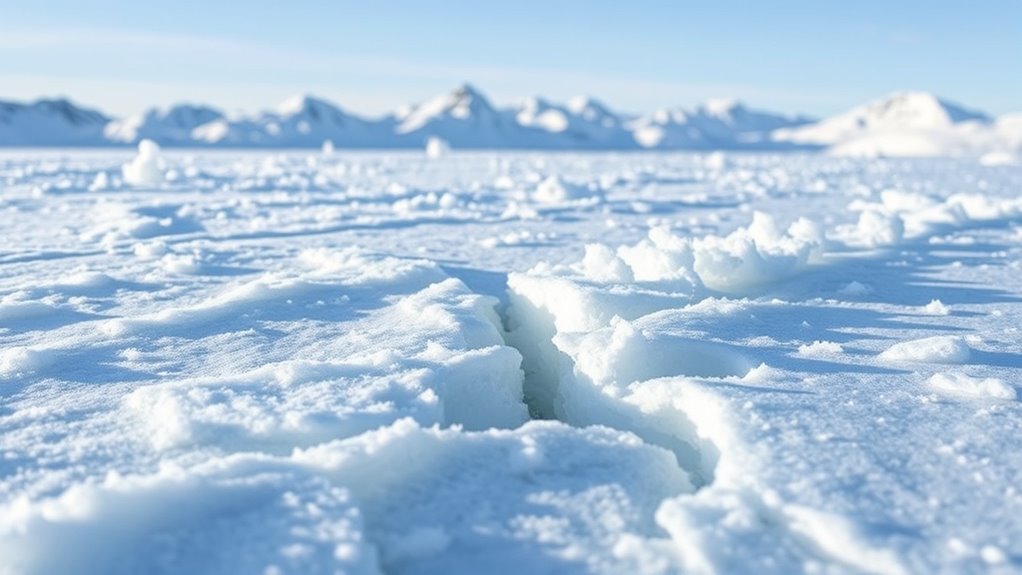
Understanding the mechanics of ice shear is essential because it helps you grasp how and why ice fractures at the edges. When stress exceeds the ice’s internal strength, cracks form, often starting at weak points or imperfections. At the edges, tension builds due to temperature fluctuations, weight, or movement, making them more vulnerable. Ice behaves like a brittle material, so it doesn’t bend much before snapping. Instead, it fractures suddenly when the stress surpasses its limit. Shear forces occur when layers slide past each other along a plane, causing the ice to break along that line. Recognizing these mechanics allows you to anticipate where weakness might develop and plan measures to minimize stress concentrations, ultimately helping you prevent edge failure and maintain stability. Advances in machine learning algorithms can aid in predicting stress points and improving preventive strategies in ice management.
Factors Contributing to Edge Instability
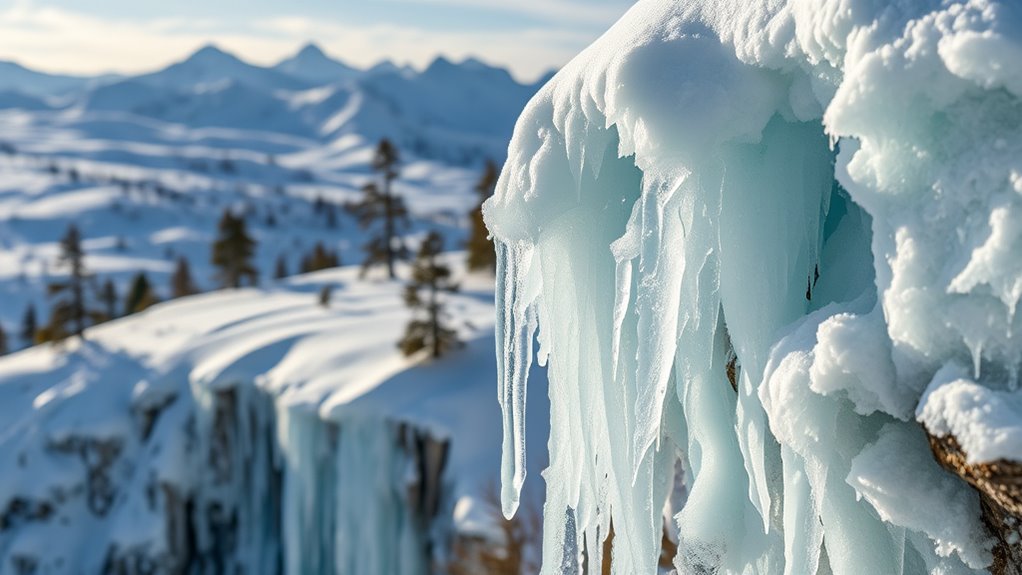
Several factors can weaken the stability of ice edges, making them more susceptible to shear failure. One primary factor is uneven load distribution, which creates stress points that can crack or fracture the ice. Wind and water currents also play a significant role by eroding the edge or exerting lateral forces, destabilizing the structure. Additionally, the presence of cracks, weak layers, or pre-existing flaws within the ice reduces its overall strength. Surface melting or thin ice cover increases vulnerability, especially during rapid temperature changes. Human activity, such as heavy foot traffic or equipment placement near the edge, can add pressure and cause instability. Understanding these factors helps you identify risky areas and take preventative measures to maintain edge stability and prevent shear failures. Incorporating contrast ratio considerations can also improve your ability to assess and monitor ice conditions visually, especially in low-light situations.
The Role of Temperature Fluctuations in Ice Shear
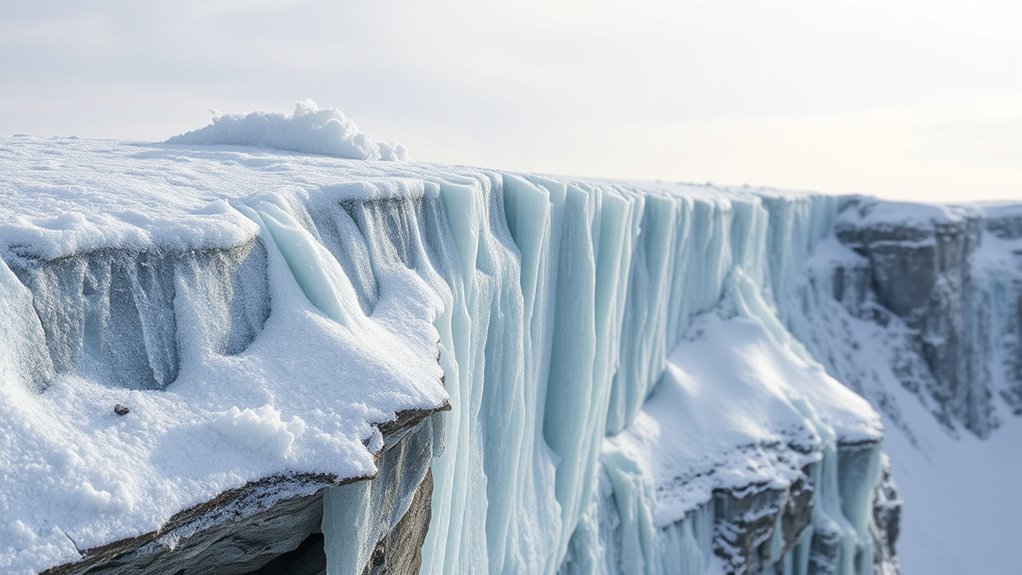
Temperature fluctuations markedly influence the stability of ice edges by causing expansion and contraction cycles that weaken the ice structure. When temperatures rise, ice expands, creating stress within the edge, which can lead to cracks or fractures. Conversely, cooling causes contraction, increasing tension along existing weaknesses. Repeated cycles accelerate deterioration, making the ice more susceptible to shear failure. Sudden temperature changes, such as warm days followed by cold nights, intensify these effects. You need to monitor temperature patterns closely to predict when ice is most vulnerable. By understanding how fluctuations cause structural fatigue, you can implement measures like controlled cooling or insulation to minimize stress. Managing temperature consistency is essential to prevent ice shear and maintain the integrity of the ice edge over time. Sound design techniques can be employed to create auditory cues that alert to changing conditions or stresses within the environment.
The Impact of Snow Accumulation and Load Distribution
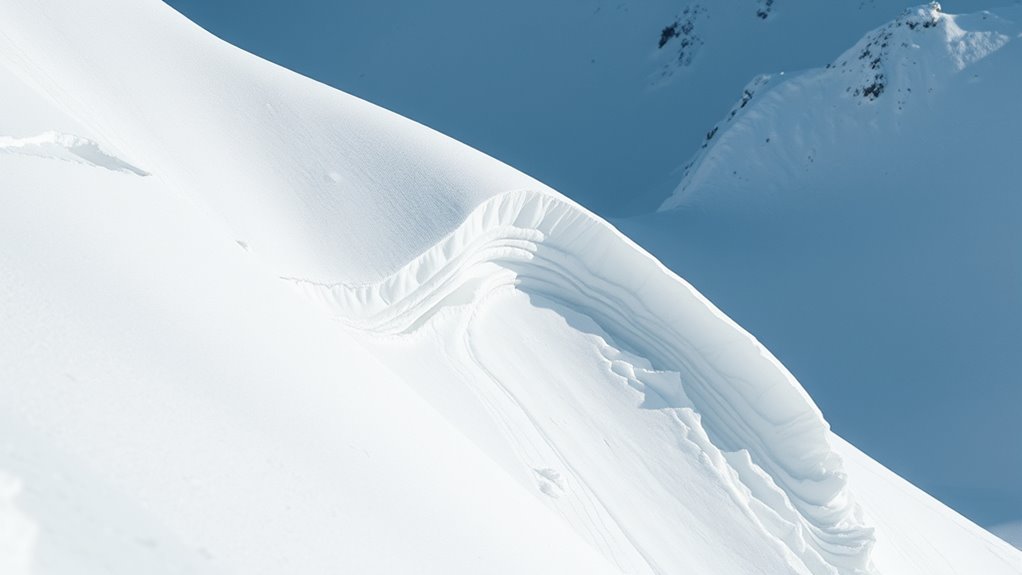
Snow accumulation can vary greatly, affecting the overall load on your structure. Proper load distribution strategies help prevent uneven stress that might lead to ice shear. Understanding these factors is key to maintaining safe and durable edges. Utilizing efficient workflow techniques can also optimize your maintenance efforts and ensure consistent safety standards.
Snow Load Variability
Snow load variability markedly influences the risk of ice shear at roof edges by affecting how snow accumulates and distributes across surfaces. When snow falls unevenly or melts and refreezes, it creates uneven loads that can weaken edge supports. You might notice certain areas with thicker snow layers or pockets of denser ice, increasing the likelihood of shear failure. This variability means you need to be alert to changing snow conditions and adjust your assessments accordingly. Additionally, understanding the efficiency ratings of snow removal systems can help optimize maintenance and safety strategies.
Load Distribution Strategies
Effective load distribution is essential for minimizing ice shear risks at roof edges, especially when snow accumulates unevenly. You should spread snow loads evenly across your roof to prevent concentrated weight that causes stress at the edges. Use structural elements like load-bearing beams, braces, or snow guards to redirect and balance the weight. Regularly removing excess snow from specific areas helps prevent uneven buildup. Consider installing heating cables or insulation to reduce snow accumulation on critical sections. Properly designed drainage systems also help manage melting snow, reducing load fluctuations. Additionally, understanding best practices for snow management can further enhance safety and longevity of your roof. By evenly distributing loads and controlling snow buildup, you lower the risk of ice shear at the edges, protecting your roof from potential damage and ensuring safety during heavy snow seasons.
Recognizing Early Signs of Shear Failure
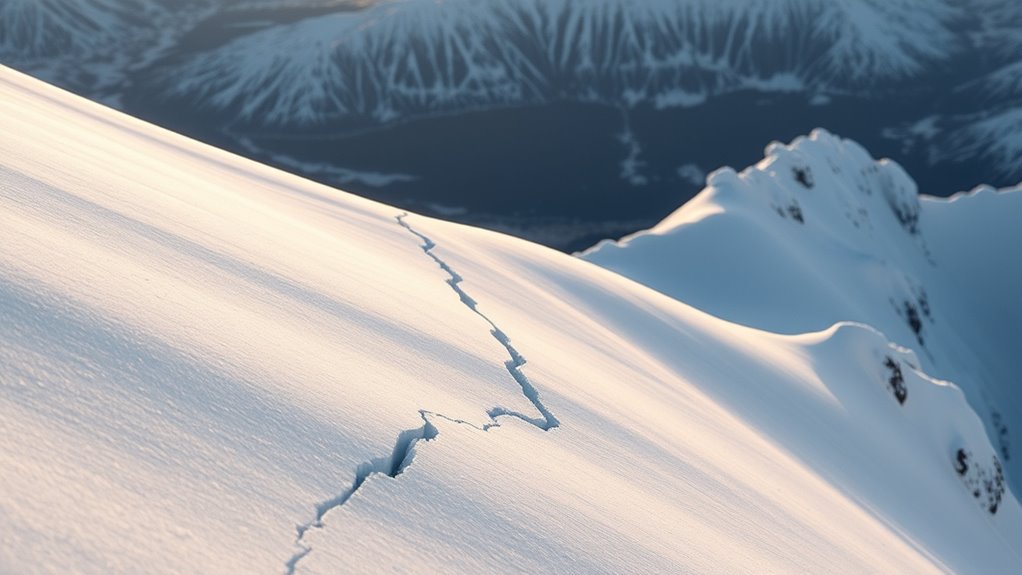
You should keep an eye out for visible cracks or unusual lines forming along the ice edge, as these can be early signs of shear failure. Unexpected movement of snow or ice is another warning that stress is building beneath the surface. Recognizing these signs early helps you take action before a full failure occurs. Ensuring proper filtration and pump protection can prevent debris buildup that might contribute to shear issues.
Visual Crack Indicators
Have you ever noticed small cracks forming along the edge of an ice sheet? These cracks can be early warning signs of shear failure. Keep an eye out for:
- Fine, hairline fractures that spread across the surface
- Cracks that deepen or widen over time
- Patterns resembling spider webs or starbursts
- Sudden shifts in crack direction
- Cracks appearing near weak points or previous damage
These visual cues indicate that stress is building within the ice. Recognizing them early helps you take action before a larger failure occurs. Regularly inspecting the edges, especially after temperature changes or heavy loading, can prevent unexpected collapses. Staying vigilant with your visual assessments makes all the difference in maintaining safe ice conditions. Incorporating accurate detection methods can enhance your ability to identify these signs early.
Unexpected Snow Movement
Unexpected snow movement can be a subtle but critical sign of shear stress building within the ice sheet. You might notice snow suddenly shifting or sliding without apparent cause, especially near the edges or over hidden cracks. These movements often occur before visible cracks or fractures develop, serving as early warning signals. Pay close attention to unusual sounds like creaking or faint cracking, which can precede larger failures. Keep track of areas where snow seems loose or less anchored, as these spots are more prone to slipping. Recognizing these signs early allows you to assess the risk of shear failure and take preventative measures. Staying alert to unexpected snow shifts can help you intervene before a potentially dangerous collapse occurs. Additionally, understanding remote work productivity can help in staying vigilant and prepared for sudden changes, ensuring timely responses to emerging hazards.
Techniques for Reinforcing Snow and Ice Edges
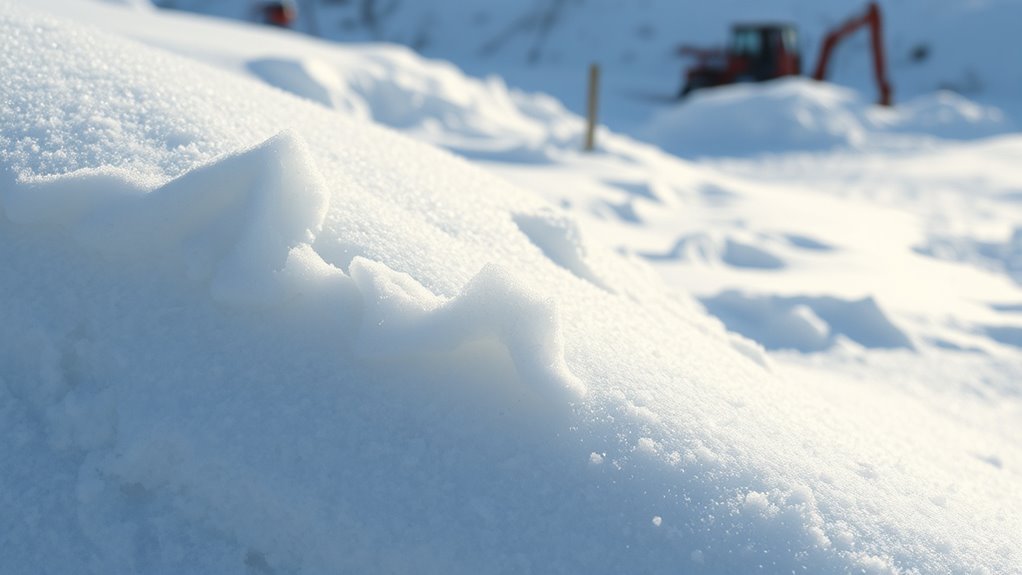
Reinforcing snow and ice edges is essential for preventing shear failures and maintaining stability. You can strengthen edges using various techniques that improve their resilience. First, compact the snow or ice thoroughly to eliminate weak spots. Adding a layer of gravel or crushed stone at the edge can provide extra support and reduce erosion. Installing barriers like snow fences or retaining walls helps contain the edge and prevent movement. You might also consider applying chemical stabilizers or sprays that increase cohesion. Finally, regular inspections and timely repairs keep the edge solid and secure. By actively reinforcing the edges, you reduce the risk of shear failure and ensure safer, more stable surfaces.
- Compact with shovels or rollers
- Add supportive gravel or crushed stone
- Install snow fences or barriers
- Use chemical stabilizers
- Perform routine inspections
Engineering Solutions for Preventing Ice Shear
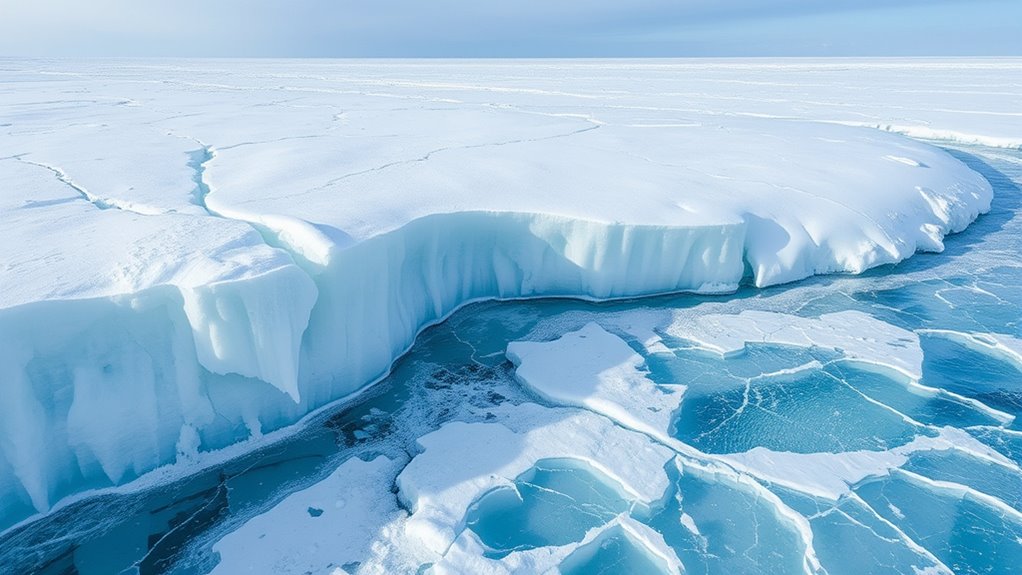
Engineering solutions play a vital role in preventing ice shear by providing structural stability and controlling movement. You can implement heated barriers or thermally insulated panels to reduce ice buildup at critical edges, minimizing stress. Reinforced supports, such as steel frameworks or tension cables, help hold ice structures in place, preventing sudden shifts. Installing adjustable anchors allows you to modify tension as conditions change, reducing shear risk. Drainage systems are essential; they divert meltwater that can weaken ice bonds. You might also consider using synthetic or composite materials to reinforce vulnerable areas without adding excessive weight. Proper design and maintenance of these structures guarantee they withstand environmental forces, and structural reinforcement enhances overall stability. By integrating these engineering solutions, you proactively reduce the likelihood of ice shear incidents.
Best Practices for Winter Sports Safety
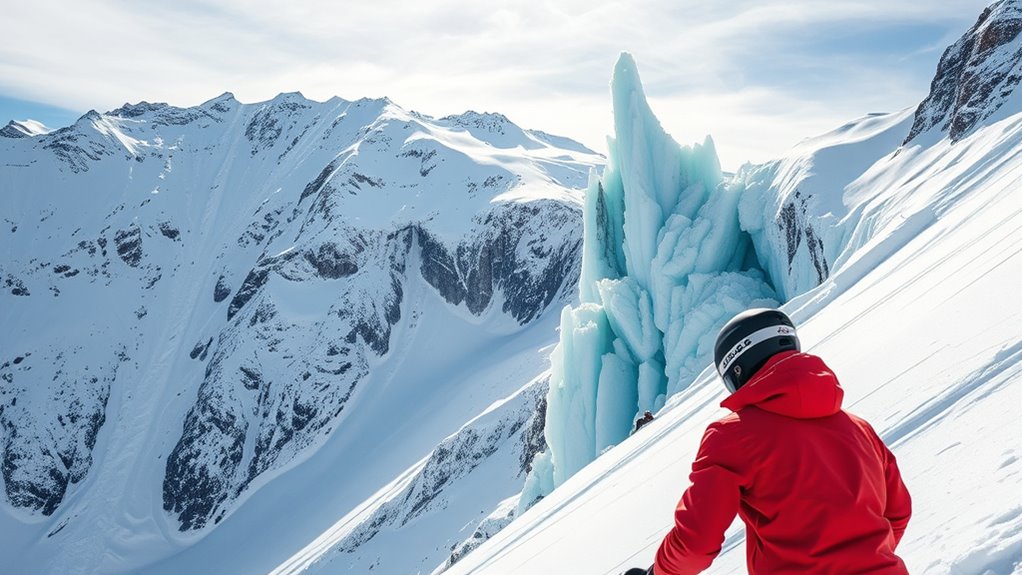
To stay safe during winter sports, you need to make smart choices about your equipment, develop your skills, and stay aware of your surroundings. Using the right gear reduces your risk, while practicing techniques improves your confidence. Being mindful of environmental conditions helps you avoid hazards and enjoy your time on the snow safely.
Proper Equipment Choices
Choosing the right equipment is essential for preventing ice shear injuries at the edge. You need gear that provides proper support, fit, and durability to keep you safe on the slopes. Start with well-fitted boots that hold your ankles securely, reducing unnecessary movement. Use bindings that match your skill level and terrain, ensuring they release appropriately under stress. Helmets and padding should be comfortable and snug to protect your head and joints without impairing movement. Always select skis or boards suited to your weight and ability to maintain control. Regularly check equipment for signs of wear and replace damaged parts promptly. Proper equipment isn’t just about performance; it’s your first line of defense against injuries caused by ice shear and edge-related accidents.
- Well-fitted boots and bindings
- Durable, quality helmets
- Appropriate ski or snowboard size
- Impact-resistant padding
- Regular gear inspections
Skill Development Strategies
Mastering proper technique and building skills can considerably reduce the risk of ice shear injuries at the edge. Focus on maintaining balanced stance and controlled movements, especially when skiing or snowboarding near edges. Practice edging drills to improve your ability to grip the snow securely and avoid sudden shifts that strain the edge. Take lessons from certified instructors who can help you refine your technique and recognize risky situations early. Develop muscle strength and flexibility through targeted exercises, which enhance your stability and responsiveness. Always start on easier terrain to build confidence and skill before tackling more challenging slopes. Consistent practice and mindful technique will help you react appropriately to changing conditions, minimizing the likelihood of ice shear incidents at the edge.
Environmental Awareness Tips
Being aware of your environment is essential for winter sports safety, especially when traversing icy or unpredictable terrain. Staying alert helps you spot hazards early and react quickly to prevent accidents. Always check weather reports before heading out to understand snow conditions and potential storms. Keep an eye out for signs of unstable ice or sudden drops. Wear bright clothing to increase visibility, and carry a map or GPS device for navigation. Listen to local advice and stay within designated areas. Be cautious around snowdrifts, thin ice, and hidden obstacles. Remember, your environment can change rapidly—staying alert means you can adapt and avoid dangers effectively. Your awareness could be the difference between a safe adventure and a risky situation.
Monitoring and Maintenance Strategies in Snowy Environments
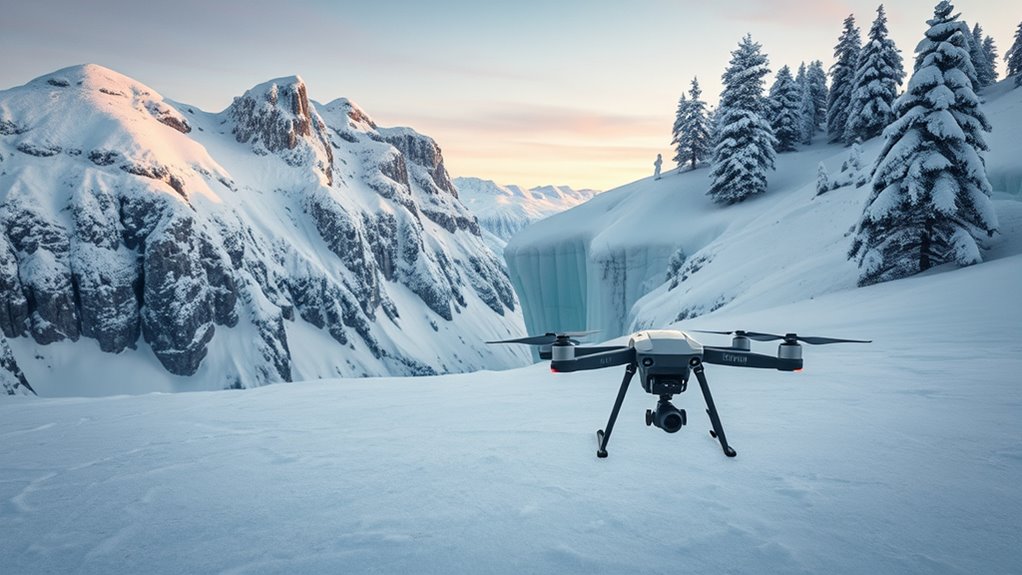
Effective monitoring and maintenance are crucial for preventing ice shear at the edges in snowy environments. You should regularly inspect edges for signs of stress, cracks, or shifting snow that could indicate instability. Use tools like snow stakes, thermometers, and visual surveys to track changes over time. Promptly address issues by removing excess snow, reinforcing vulnerable areas, or installing barriers. Maintain consistent communication with weather services to anticipate storms or temperature shifts that could worsen conditions. Keep records of inspections and repairs to identify patterns and improve your response plans. Regular upkeep minimizes the risk of sudden shear events and prolongs the integrity of edge structures. Staying vigilant and proactive ensures that your environment remains safer despite challenging winter conditions.
Community and Policy Approaches to Mitigate Risks
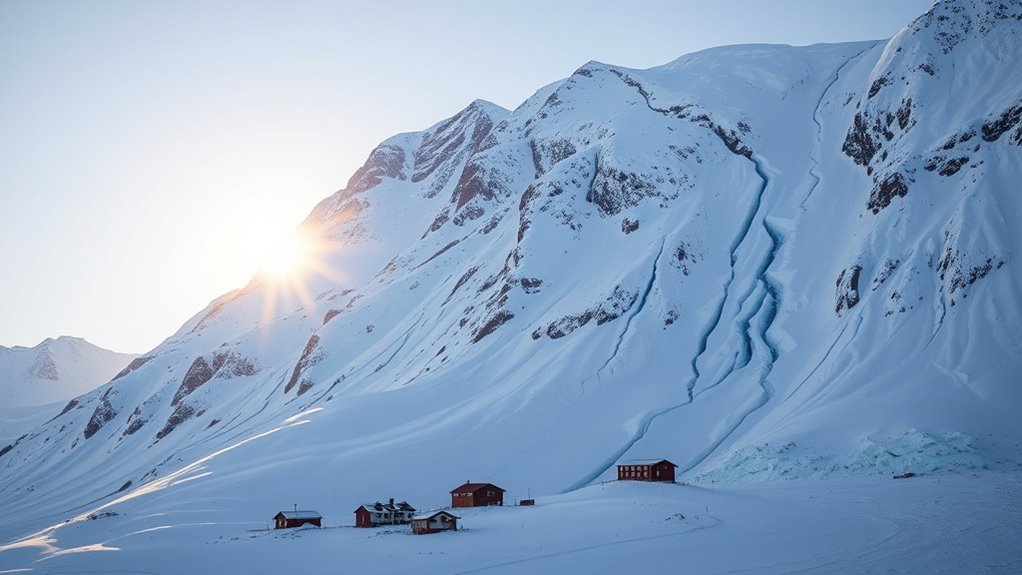
Community and policy approaches play a vital role in reducing the risks associated with ice shear at snowy edges. By working together, you can create safer environments and establish standards that minimize danger. Implementing local ordinances can enforce regular safety inspections and maintenance, while community awareness campaigns educate residents on recognizing hazard signs. Collaborating with local authorities ensures quick responses during storms. Encouraging neighborhood watch programs can help monitor unstable areas. Supporting policies that fund snow removal and ice prevention measures makes a tangible difference. These strategies empower you and your community to stay proactive, reducing accidents and promoting safer outdoor spaces. Ultimately, combined efforts foster a culture of safety and shared responsibility, making icy edges less hazardous for everyone.
Frequently Asked Questions
How Does Wind Speed Influence Ice Shear Stability?
Higher wind speeds weaken ice shear stability by increasing stress on the ice edge. When wind gusts hit, they apply force that can cause cracks or detachments, especially on thin or poorly bonded ice. You should monitor wind conditions carefully, as strong winds make ice more prone to shear failure. To prevent accidents, consider reinforcing weak areas and avoiding ice activities during high wind events.
What Materials Are Most Effective for Reinforcing Ice Edges?
You should use strong, durable materials like reinforced steel or composite materials to reinforce ice edges effectively. These materials resist cracking and shear forces better than softer options. Applying metal or synthetic reinforcements along the vulnerable edges helps distribute stress and prevent ice shear failures. Regular inspections and maintenance ensure these reinforcements stay effective, allowing you to manage risks and maintain stability in icy conditions.
Can Artificial Heating Prevent Ice Shear Failures?
Imagine a fortress resisting attack—that’s how artificial heating can prevent ice shear failures. Yes, it can be effective by maintaining consistent temperatures along the ice edge, reducing thermal stress that causes shear. You activate heating systems strategically, and you diminish the risk of sudden failures. However, it’s not foolproof; careful control and energy considerations matter. Properly applied, artificial heating becomes a powerful tool to strengthen ice stability.
How Does Underlying Terrain Affect Ice Edge Strength?
Your underlying terrain plays a vital role in ice edge strength by influencing how well the ice adheres and transfers stress. Hard, stable bedrock offers better support, reducing the risk of shear failure. Conversely, soft or uneven terrain creates weak points, making the ice more prone to cracking or shearing under pressure. You should assess terrain conditions carefully and consider reinforcement methods to enhance stability and prevent failures.
What Are Long-Term Climate Impacts on Ice Shear Risks?
Long-term climate impacts increase ice shear risks by causing warmer temperatures, which weaken ice structures over time. As global warming continues, you’ll see more frequent and severe ice shearing events, especially in vulnerable areas. Melting and thinning ice edges become less stable, making it harder to predict and prevent failures. To stay safe, you need to monitor climate trends closely and adapt your prevention strategies accordingly, emphasizing resilience and early warning systems.
Conclusion
So, next time you’re marveling at that icy cliff or daring to ski the snowy edge, remember: ice shear isn’t just nature’s way of saying “hello,” it’s a warning sign you should probably heed. With proper understanding, maintenance, and maybe a little common sense, you can avoid becoming the star of your own frosty disaster. After all, who wants a winter thrill turned icy spill? Stay smart, stay safe, and keep the snow where it belongs—on the ground.
